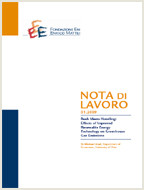Biodiversity Valuation in Developing Countries: A Focus on Small Island Developing States (SIDS)

12.09.2010
Sonja S. Teelucksingh, Paulo A.L.D. Nunes
Q01, Q57
Biodiversity, Developing Countries, Small Island Developing States
Climate Change and Sustainable Development
Carlo Carraro
The Millennium Development Goals explicitly recognise “sustainable development” as a target. A step towards this is a greater understanding of the significant role of biodiversity in rural communities of developing countries who depend most on the ecosystem goods and services and who as a result may suffer most from its continued degradation. Understanding the input of biodiversity in developing countries to the provision of the ecosystem goods and services (EGS) that are essential to their human well-being is seen as a significant first step in sustainable development, and environmental valuation is a necessary tool for achieving this objective. However, valuing biodiversity in a developing country context can be an intricate affair. While economic valuation literature yields a range of tried and tested methodological techniques for measuring biodiversity, the question remains as to whether these generalised techniques are capable of revealing the complexities of local environmental use in developing countries. A heterogeneous group, “developing countries” can be characterised by a range of factors existing in different intensities that can (1) impact the ways in which local communities interact with their environmental resources (2) impact the efficacy of the methodological and data collection process (3) impact the values obtained from the application of valuation techniques and (4) impact the implementation, success and sustainability of policy and management prescriptions. This paper attempts to address these issues by discussing the main characteristics of developing countries that can impact the biodiversity valuation process and, with specific reference to Small Island Developing States (SIDS), discussing how knowledge of these characteristics can assist the valuation process to better reveal the complex interaction between biodiversity and human welfare in a developing country context.
